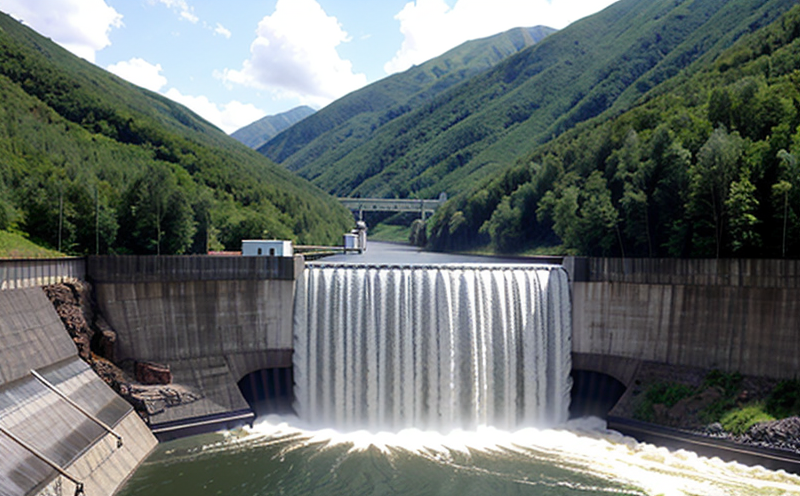ASTM G32 Cavitation Erosion Resistance Testing of Materials
The ASTM G32 standard is a critical tool used to evaluate materials' resistance to cavitation erosion, a destructive phenomenon that can significantly impact the performance and lifespan of components in hydropower systems. This test assesses the ability of materials to withstand the erosive forces caused by rapidly collapsing bubbles within flowing liquids under high pressure.
Hydropower turbines are subjected to extreme conditions due to their continuous operation and exposure to water flow. Cavitation can form on the surfaces of turbine blades, leading to erosion that weakens these components over time. By conducting ASTM G32 tests, manufacturers and engineers can ensure that materials used in hydropower systems meet stringent standards for durability and reliability.
The test involves subjecting a material sample to controlled cavitation conditions in a laboratory setting. During the process, the sample is exposed to high-speed water jets containing free oxygen, which promotes the formation of cavitation bubbles. These bubbles then collapse, generating intense mechanical impacts that simulate real-world operating conditions.
During this testing procedure, it's essential to prepare the specimens correctly to ensure accurate results. The sample should be machined into a specific geometry relevant to the component design, such as a flat disc or cylindrical shape. The surface finish and orientation are also crucial factors that can influence the outcome of the test.
The ASTM G32 methodology includes detailed instructions for setting up the testing apparatus, calibrating the equipment, and conducting the actual tests. It specifies the type of water used, the flow rate, and the duration of exposure to cavitation conditions. After the test, the sample is inspected visually or through advanced imaging techniques to assess any signs of erosion.
The acceptance criteria for ASTM G32 testing are based on visual inspection and quantification of surface damage. Materials must meet predefined thresholds regarding the extent and depth of erosive wear before being considered suitable for use in hydropower applications. Meeting these standards ensures that materials can withstand the harsh environments typical of such systems.
Understanding the importance of ASTM G32 testing is crucial for quality managers, compliance officers, R&D engineers, and procurement professionals involved in selecting appropriate materials for hydropower components. This test not only helps prevent costly failures but also contributes to more efficient and sustainable energy production processes.
Why It Matters
The significance of ASTM G32 testing cannot be overstated, especially in the context of hydropower systems. Cavitation erosion poses a significant threat to the integrity of turbine components, potentially leading to premature failure and reduced efficiency. Ensuring that materials used meet the rigorous standards set by this test is vital for maintaining optimal performance and extending the lifespan of these critical systems.
- Prevents Component Failure: By identifying materials resistant to cavitation erosion early in the design process, potential failures can be avoided, reducing downtime and maintenance costs.
- Enhances Efficiency: Durable materials contribute to more efficient energy conversion processes, improving overall system performance.
- Sustainability: Longer-lasting components mean less frequent replacement, which is beneficial for both environmental and economic reasons.
Scope and Methodology
The ASTM G32 scope focuses on the evaluation of materials used in hydropower systems that are exposed to cavitation erosion. The primary purpose is to determine the resistance of various materials under controlled laboratory conditions simulating real-world operating conditions.
The methodology involves preparing specimens according to specified dimensions and surface finishes, then exposing them to high-pressure water jets containing free oxygen. The test apparatus typically includes a chamber where the specimen can be submerged in flowing water, creating cavitation bubbles that collapse around the sample.
After exposure, the samples are carefully inspected for signs of erosion, including visual inspection and quantitative analysis using advanced imaging techniques like laser profilometry or scanning electron microscopy. The results provide valuable insights into the material's performance under cavitation stress.
Why Choose This Test
- Accurate Assessment: ASTM G32 provides a precise method for evaluating materials' resistance to cavitation erosion, ensuring reliable data for decision-making.
- Sector-Specific: Tailored to the unique challenges faced by hydropower systems, this test ensures that only suitable materials are used in critical components.
- International Recognition: Compliance with ASTM G32 standards is recognized globally, enhancing the reputation of manufacturers and suppliers.
- Cost-Effective Solutions: By identifying robust materials upfront, unnecessary replacements and repairs can be avoided, leading to cost savings over time.





